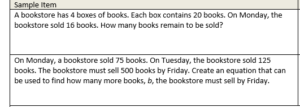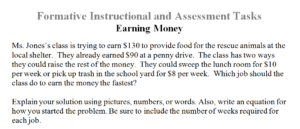Solve two-step word problems using the four operations. Represent these problems using equations with a letter standing for the unknown quantity. Assess the reasonableness of answers using mental computation and estimation strategies including rounding.
[divider] [/divider] Students are able to…
- Solve problems using models, pictures, words and numbers.
- Use a variety of problem solving strategies, including restating the problem in their own words, making models, and drawing pictures to represent their thinking.
- Explain how they solved the problem using accurate mathematical vocabulary and why their answer makes sense.
[divider] [/divider] Students are able to…because teachers:
- Scaffold problems that use all four operations, including two-step problems that call for the use of different operations.
- Support students in interpreting problems, including identifying given, needed, and wanted information.
- Expect students to explain their solution strategies and to justify why their solution makes sense.
[divider] [/divider] Questions to ask students:
Sample problem: Rita found 4 eggs. Joe found 3 times as many eggs as Rita. They put their eggs in the same basket. How many eggs were in the basket?
- Explain how you solved the scenario using precise mathematical vocabulary.
- Sample answer that indicates understanding: I had to multiply 3 x 4 to get 12 eggs for Joe and add that to Rita’s 4 eggs for a total of 16 eggs. I know my answer makes sense because if I subtract $2.25 from the total, $3.10, I get the cost of the apple which is 85 cents.
- Explain how your model represents the problem.
- Sample answer that indicates understanding: I made an array with 4 tiles to represent Rita’s eggs. I made three of those same arrays of 4 to represent Joe’s eggs, which ended up being 12. All of the tiles together give me the total 16 eggs in the basket.
[divider] [/divider] FSA Notes:
Cognitive Complexity Level: 2 – Basic Application of Skills and Concepts
Achievement Level Descriptors:
2- solves two-step problems using addition and subtraction within 100 and multiplication and division using factors of 1, 2, or 5
3- solves two-step word problems using the four operations and using equations with a letter for the unknown quantity
4- assesses the reasonableness of answers using mental computation and estimation strategies including rounding
5- creates a two-step word problem from an equation with a variable
Assessment Limits:
Adding and subtracting is limited to whole numbers within 1,000.
All values in multiplication or division situations may not exceed whole number multiplication facts of 10 × 10 or the related division facts.
Students may not be required to perform rounding in isolation.
Equations may be provided in items.
[divider] [/divider] Additional Resources:
Additional in depth content knowledge
LearnZillion Video: Solving Two-Step Problems Using a Model
Kahn Academy Video: Unknowns with Multiplication and Division
[divider] [/divider] Sample Formative Assessment Tasks:
[divider] [/divider] Resources/Tasks to Help your Child at Home:
As your child is creating models to represent one- and two-step word problems, challenge them to write equations with variables to represent each step in their model. Students can then try to represent all of the steps in one equation. *Students do not need to know the order of operations.
Provide real-world opportunities to estimate sums or differences, including two-step problems. For example, rounding to estimate total cost of items at a store and estimating change that will be received; or rounding to estimate nutritional information of ingredients.
Khan Academy: Two-Step Estimation Problem – Marbles
Khan Academy: Two-Step Problem – Truffles
Math Playground: Thinking Blocks Modeling Tool
PBS Games: Estimation Contraption

